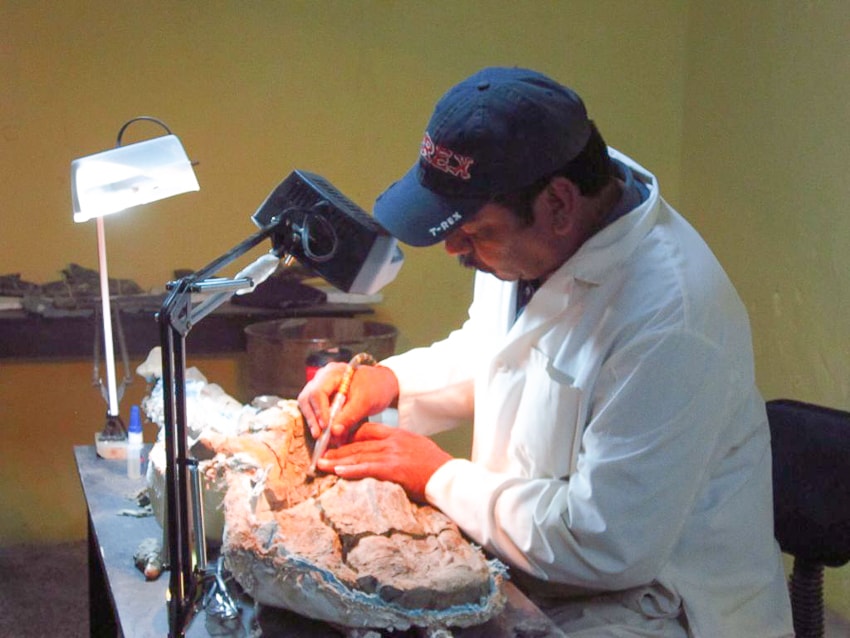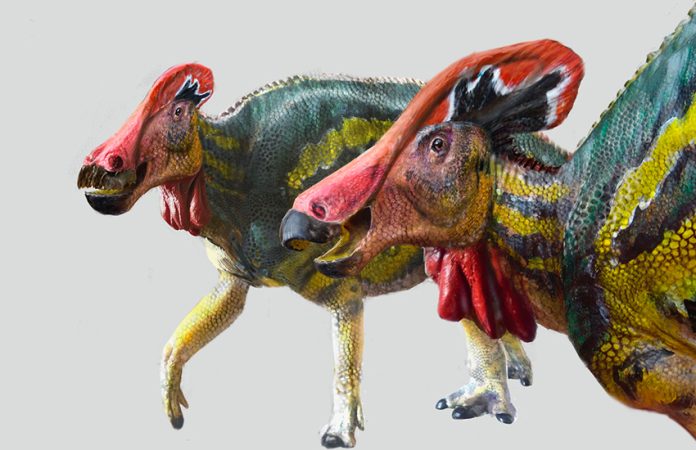A team of paleontologists has identified a new species of dinosaur after unearthing its 72-million-year-old remains in Coahuila eight years ago, the National Institute of Anthropology and History (INAH) announced Thursday.
The institute said in a statement that paleontologists discovered in 2013 the remains of a large herbivorous dinosaur that died 72 or 73 million years ago in a body of water with copious amounts of sediment that covered and preserved it throughout the ages.
The paleontologists determined this year that the remains are of a new species of crested dinosaur that has been named Tlatolophus galorum.
In 2013, during a dig in the municipality of General Cepeda, INAH and National Autonomous University paleontologists found numerous parts of the dinosaur, including its skull.
“Once we recovered the tail, we kept digging below where it was located. The surprise was that we began to find bones such as the femur, the scapula and other elements,” said Ángel Alejandro Ramírez Velasco of UNAM.

Ramírez, who coauthored an article on the discovery of the new species, said that among the bones was an elongated one in the form of a water drop.
“At the time I said that it was part of the pelvis, but another one of the project participants, José López Espinoza, said it was the animal’s head,” he said.
What the paleontologists had found was in fact the 1.3-meter-long crest of the dinosaur. They also found several other parts of the reptile’s head, including lower and upper jawbones, its palate and a part known as the neurocranium, which encased the brain.
All told, the paleontologists were able to recover almost 80% of the dinosaur’s skull. They compared the remains they found with those of other dinosaurs known to have inhabited the region such as the Velafrons coahuilensis.
“The examination showed that the crest and the nose were different from the Velafrons and more similar to … another tribe of hadrosaurids [a type characterized by a duck-bill shape to the snout]: the Parasaurolophus genus,” INAH said.
However, the crest of the “General Cepeda specimen” with its water-drop form wasn’t an identical match to the “tubular crest of the Parasaurolophus, … which inhabited the actual territories of New Mexico and Utah, United States, as well as Alberta, Canada, and which has been depicted in movies such as Jurassic Park,” the institute said.

“After all these discoveries, we convinced ourselves that we were faced with a new genus, a kind of crested dinosaur,” said Felisa Aguilar Arellano, an INAH researcher in Coahuila.
The paleontologists’ conclusion was supported by independent members of the scientific community, who reviewed an article on the discovery published in the journal Cretaceous Research.
INAH said the name given to the new species is a tribute devised by the paleontologists.
Tlatolophus comes from the Náhuatl word tlahtolli, which means word — a reference to the animal’s ability to perceive low-frequency sounds and thus the possibility that the species was “talkative” — and the Greek word lophus, which means crest.
The galorum part of the name pays tribute to people who assisted the paleontologists who made the discovery. Ga acknowledges the contribution of philanthropist Jesús Garza Arocha, while lorum recognizes the support of the López family, who provided accommodation and meals to the paleontologists while they were working in General Cepeda.
INAH also highlighted that the tail of the Tlatolophus galorum is on display at a museum in the municipal seat, located about 60 kilometers west of Saltillo.
“This fossil, which remains under investigation, is an exceptional case in Mexican paleontology because for it to be conserved in the conditions in which we found it, highly favorable events had to occur millions of years ago when Coahuila was a tropical region,” Aguilar said.
Paleontologists have found the remains of many dinosaurs in Coahuila, including those of a genus — the Parksosaurus — that wasn’t previously known to have existed in Mexico.
Mexico News Daily
